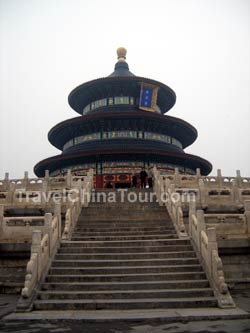I've been busy the past few days after finishing up my Beijing tour. I'm actually in my home town spending time with my family and relatives, eating hot and spicy szechuan food, playing mahjong, and just relaxing and enjoying life. :) I have a little more time today, so I'm trying to finish up my entries for the last day I spent in Beijing touring.
I had just two destinations planned out for my last day in Beijing. I had already visited the Great Wall, Beihai Park, Forbidden City, Tiananmen Square, Summer Palace, and many of the other popular tourist destinations in Beijing. For that day, I just planned on touring Beijing's Temple of Heaven, and do some shopping at Xidan.
Since I had a pretty relaxed schedule that day, I woke up a bit later around 9am, and took a taxi to the Temple of Heaven at around 9:30. I was dropped off at the North gate at the Heaven Temple, and like everywhere else in China, there's always a crowd.

A photo of the North Gate of the Temple of Heaven in Beijing, China.
About the Beijing Temple of Heaven
The Heaven Temple in Beijing was the place where the emperors of the Ming and Qing Dynasties worship the heaven and pray for bumper crops. The northern part of the outer sourrounding wall is semi circular and the southern part is a square shape - this was symbolic of the ancient belief that the heaven was round, and the earth was square.
The Temple of Heaven includes several key buildings such as:
- Hall of Prayer for Good Harvests
- Hall of Heavenly Emperor
- Imperial Vault of Heaven
- The Beamless Hall
- The Seven Star Stones
- Nine Dragon Juniper
The Heaven Temple was first built in 1420, and it is the largest architectural structure for worshipping Heaven in the world. It was placed under state preservation program in 1961, and in 1988 was recognized by UNESCO as one of the human heritages of the world.
Touring The Heaven Temple
The entrance ticket costs $35yuan, and after entering the North gates, I headed south down a long path sourrounded by trees on both sides toward the key north worshipping structure called the "Hall of Praying for Good Harvests".

Stair leading up to the entrance to the Hall of Pray for Good Harvests.
At the end of the path is the long stair way leading to the entrance of the Hall of Praying for Good Harvests. At the gates, you must present your ticket again, and the portion that grants you access to this hall is removed. The Heaven Temple is frequented often by the local Beijing people, so the key structures inside require separate entrance tickets.
I believe the basic entrance ticket is $10yuan which does not include entrance to the key workshipping buildings. The $35yuan ticket I purchsed includes entry passes to all the key worshipping structures. I'm not sure on this, but I'm pretty sure the locals can purchase annual passes at a deep discount. This way, the local Beijing people have access to the parks and recreational areas in and around the Temple of Heaven without paying the full fee to access the worshipping buildings.
All types of activities take place in parks such as the ones inside the Temple of Heaven. In China, community activities are common place where large groups of people gather to do exercising, dancing, playing drums, etc. While I was at the temple of heaven, there was a large gathering of local people dancing to old Chinese music at the recreation area just infront of the entrance to the Hall of Praying for Good Harvests.

Hall of Praying for Good Harvests
After entering the gates you come up to a large circular platform with staicases in multiple directions which leads up to the central building - Hall of Praying for Good Harvests. This hall was constructed in 1420 during Ming Emperor Yongle's reign. Its original layout was 2 rows of halls. A front hall with 9 bays, and a rear hall with 7 bays. In 1751, Qing Dynasty Emperor Qianlong removed the rear hall due to its "disorderly arrangement". What you see in the photo above is the front hall, which houses the divine tablets for worshipping the gods.
In the same area, just a little south of this Hall are two buildings which are now museums that has various ancient artifacts on display.
Continue to part 2. |